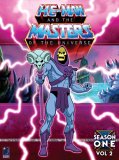| Reviews & Columns |
|
Reviews DVD TV on DVD Blu-ray 4K UHD International DVDs In Theaters Reviews by Studio Video Games Features Collector Series DVDs Easter Egg Database Interviews DVD Talk Radio Feature Articles Columns Anime Talk DVD Savant Horror DVDs The M.O.D. Squad Art House HD Talk Silent DVD
|
DVD Talk Forum |
|
|
| Resources |
|
DVD Price Search Customer Service #'s RCE Info Links |
|
Columns
|
|
|
He-Man and the Masters of the Universe: Season One, Volume Two
BCI Eclipse // Unrated // February 14, 2006
List Price: $49.98 [Buy now and save at Amazon]
When BCI Eclipse announced that they had acquired the rights to "He-Man and the Masters of the Universe" and other Filmation properties, there was an audible groan from fans. Until "The Best of He-Man and the Masters of the Universe," 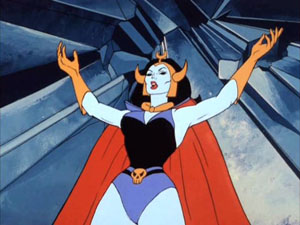 BCI's catalogue was composed entirely of public-domain material, microbudget movies, and pornography with titles like "Awesome Strippers"—not exactly a company you trust to do justice to a nostalgic childhood favorite.
BCI's catalogue was composed entirely of public-domain material, microbudget movies, and pornography with titles like "Awesome Strippers"—not exactly a company you trust to do justice to a nostalgic childhood favorite.
But then something interesting happened: they released a surprisingly great DVD that set a new bar for video, packaging, and extras for classic animation. Season One, Volume One confirmed it, and suddenly people knew who BCI was. Animation fans started saying things like, "I hope BCI gets the license," or, "I wish Warner Bros. would have given it the 'He-Man' treatment." And last fall's Gone in 60 Seconds: Collector's Edition proved that they could do a loaded live-action special edition just as well as the big guys.
So if this is a new direction that BCI is headed, I would say: keep it up! It seems like fans can expect big things for future releases like "Blackstar" and "The New Adventures of Zorro." Now if they would only announce Flash Gordon: The Greatest Adventure of All, I would be one happy reviewer.
Anyway, He-Man. Season One, Volume Two wraps up the first season of "He-Man and the Masters of the Universe," and by this point, you can tell the writers were a little tired of the standard "Skeletor gains a new power and He-Man must stop him" hijinks of the previous 33 episodes. In fact, it's pretty surprising just how little Skeletor shows up in this set. Even in those cases where he factors into the story, he's not lording some ancient artifact over everyone. He's moved on. He's over that. That's not how he rolls anymore.
Swooping in to fill the bad guy vacuum is an array of inventive one-shot villains from all over Eternia, including Shokoti (a gothic, vampire-like sorceress), Lord Masque (living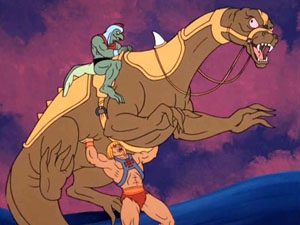 smoke bound to a magical mask), and Darkdream (an evil, robed shadow whose arrival is heralded by nightmares). Not coincidentally, most of the memorable villains have memorable episodes as a result. Skeletor's henchmen get fleshed out, too, with episodes surrounding Evil-Lyn, Mer-Man, Clawful, and especially Trap Jaw operating entirely independently of Skeletor and either working on their own or partnering with someone.
smoke bound to a magical mask), and Darkdream (an evil, robed shadow whose arrival is heralded by nightmares). Not coincidentally, most of the memorable villains have memorable episodes as a result. Skeletor's henchmen get fleshed out, too, with episodes surrounding Evil-Lyn, Mer-Man, Clawful, and especially Trap Jaw operating entirely independently of Skeletor and either working on their own or partnering with someone.
In some cases, the bad guys aren't even really bad. Granamyr, the title dragon in "The Dragon's Gift," is basically good, but he's also arrogant, greedy, and completely uncooperative. He also knows (and knows He-Man knows) that he could squish He-Man like a bug, or teleport him to a demon dimension with the slightest provocation.
Even if they are evilish, most of them have no interest in taking over Eternia. Queen Sumana, from "Trouble in Arcadia," runs a sexist Amazonian society that has enslaved all of its men and forces them to work underground in unsafe mines. Lord Tyrin and Lady Valtira were once evil but eventually decide that their love for each other is more important in "The Sleepers Awaken." And Aremesh, a robot made from pure energy in "Return of Evil," is just a mercenary hired to do a job.
You might think that the inconsistant dynamic of the Parade of Villainy means that there would be more mediocre episodes on this set than the first one, but that's really not the case. Of course, there are some genuinely bad episodes. Some of the worst offenders include "It's Not My Fault," a preachy episode about learning to take responsibility; "Valley of Power," about some magic water and a man with an egg; "Return of the Gryphon," about an annoying kid who's more interested in his own popularity than stopping a ridiculous-looking monster from killing people and destroying their homes; and "Quest for the Sword," about a simple-minded rock creature that thinks having a sword makes him a leader.
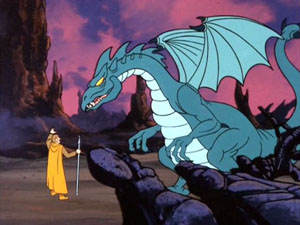 Easily the worst of the set, though, is "The Huntsman," an inappropriately political episode that flatly states that hunting should be illegal. Baron Grod, the title character, wants to bag the last unicorn on Eternia, and Adam and Teela are intent on talking him out of it. After greeting them warmly, Grod is given a lecture by the pair on how hunting is evil. When he refuses to back down, they storm out and threaten to have it outlawed. Grod calls up the leader of a tribe of ogres and tells him to kidnap the two until the hunt is complete.
Easily the worst of the set, though, is "The Huntsman," an inappropriately political episode that flatly states that hunting should be illegal. Baron Grod, the title character, wants to bag the last unicorn on Eternia, and Adam and Teela are intent on talking him out of it. After greeting them warmly, Grod is given a lecture by the pair on how hunting is evil. When he refuses to back down, they storm out and threaten to have it outlawed. Grod calls up the leader of a tribe of ogres and tells him to kidnap the two until the hunt is complete.
The baron succeeds in his mission—he only places the animals in suspended animation, by the way—and as if there were any doubt as to his character, he flies back in the same model of ship that Skeletor uses. A timely He-Man shows up to free Teela, and together they break down the door to Grod's castle and create havoc by unsuspending various dangerous animals to teach the baron "how it feels to be hunted." He learns his lesson, of course ("I never knew!"), and promises to free the rest of the animals. Back at the palace, King Randor is only too happy to outlaw all hunting, as Teela says, to force "these hunters" not to harm the unicorn, and, I assume, bunny rabbits, pandas, and kittens, too. At the end I thought that maybe Teela would make a statement that not all hunters are like Baron Grod (and will call out a hit on you if you cross them), but the moral was about not losing your cool when you get in an argument.
I don't hunt—hell, I buy free-range eggs and meat, given the choice—but even I was offended by this propagandistic drivel.
In any event, there are more than enough good episodes to balance out the bad ones. In "The Dragon's Gift," the dragon Granamyr demands that He-Man take a life to save a life. "The Search" asks if He-Man can resist the temptation of ultimate power, even if he could use it to wipe out all evil from the universe. Lord Masque, a neat villain in his own right, attempts to resurrect an even greater evil in "House of Shokoti, Part 1," and "House of Shokoti, Part 2" features the wicked sorceress raised by Masque preparing to unleash her evil across Eternia. Darkdream plunges Eternia into permanent midnight in "Eternal Darkness," while Teela and Evil-Lyn have to team up in "The Witch and the Warrior." And, in a turn of events, the ancient dragon must seek He-Man's help in "The Return of Granamyr."
My favorite episode on the set is "Golden Disks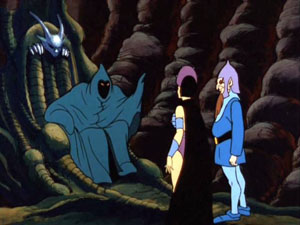 of Knowledge," however. The episode begins with disconcerting but harmless illusions in Grayskull annoying the Sorceress sufficiently to ask He-Man to help her figure out their cause. Orko discovers that, much to their surprise, Zanthor, a prisoner in the Phantom Zone, is trying to contact them. He says that he seeks to redeem himself, but the Sorceress and Zodac aren't interested. They reveal that Zanthor was once a member of the Council of the Wise, but in a moment of weakness sided with Skeletor by stealing for him the Golden Disks of Knowledge, representing the combined wisdom of the council. This allowed the villain to become the powerful sorcerer he is. Despite this, He-Man convinces them to give Zanthor a chance to atone for his crime, and together the pair infiltrate Snake Mountain in an attempt to recover the disks.
of Knowledge," however. The episode begins with disconcerting but harmless illusions in Grayskull annoying the Sorceress sufficiently to ask He-Man to help her figure out their cause. Orko discovers that, much to their surprise, Zanthor, a prisoner in the Phantom Zone, is trying to contact them. He says that he seeks to redeem himself, but the Sorceress and Zodac aren't interested. They reveal that Zanthor was once a member of the Council of the Wise, but in a moment of weakness sided with Skeletor by stealing for him the Golden Disks of Knowledge, representing the combined wisdom of the council. This allowed the villain to become the powerful sorcerer he is. Despite this, He-Man convinces them to give Zanthor a chance to atone for his crime, and together the pair infiltrate Snake Mountain in an attempt to recover the disks.
So these episodes, like the last set, represent a mixed bag, but the selection is better overall. Unlike ThunderCats, the writers for "He-Man and the Masters of the Universe" recognized the rut they were digging in the first 33 episodes and decided to use the back half to expand the world of Eternia, adding to its backstory and introducing lots of interesting new characters. Skeletor is one of the most fun characters on the show; who would have thought it would get better with less of him around?
Video:
As with all of the "He-Man" DVD releases, the show is adapted from a cleaned-up PAL transfer, and it looks sharp (certainly better than it ever looked during the original broadcasts). The main problem is present in every set: anytime there's a lot of movement on screen (for example, during a fast pan, or when Cringer is transformed into Battle Cat), there is an obscene amount of pixelation. Besides the transformation scene, the other cases happen only a few times on the set. But it's an encoding issue that still needs to be corrected, and I continue to hope that it will be fixed for Season Two, Volume One.
Audio:
The language tracks consist of English and Spanish Dolby 2.0 stereo. As a result of the PAL transfer, everything is sped up by four percent, meaning voices are slightly more high-pitched than you may remember them. I didn't notice any difference, though.
Additionally, the "He-Man Invades the San Diego Comic-Con" extra is in Dolby 5.1. The rear channels are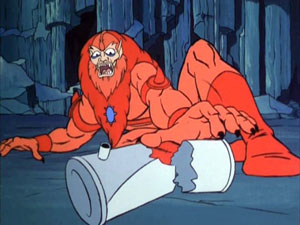 mainly reserved for crowd noise.
mainly reserved for crowd noise.
Packaging and Menus:
The set looks better than most big studio releases, with nice, large character designs on the discs and glossy scenes in the folds of the digipak. The spine features part of an image of Castle Grayskull; if you collect all four boxes it will form the complete image. As before, the opposite side is neon-colored; this time it's a disturbing shade of hot pink.
The menus are stylish but slow, especially in the episode navigation; on a slower player you might wonder if the thing has locked up. Also, when you load a disc, you are irritatingly forced to wait through all the company logos, since all buttons are disabled until you get to the main menu. Still no chapter skip; at this point I'm guessing there's not going to be one.
Extras:
Two more documentaries are on the set. "The Stories of He-Man and the Masters of the Universe" (0:30) picks up where the last one left off, and the writers, artists, directors, and producers weigh in on various episodes. Robby London explains of "Double Edged Sword" that he was concerned that action-adventure shows always showed people fighting, but no one really getting hurt. Children, especially small children, have a tough time making the distinction between fiction and reality, and so he used the episode to show that in real life people can get hurt—even the good guys. Tom Sito usually has at least one hilarious story per doc, and Paul Dini, always interesting to listen to, manages to get a jab in at Orko.
"He-Man Invades the San Diego Comic-Con" (0:37) is exactly what it sounds like. The first half, which features some of the more hardcore fans, serves as a good reminder why I avoid comic conventions. (Just kidding, He-Man fans! Don't hurt me!) The second half (starting at 0:18) is a roundtable with Erika Scheimer, Lou Scheimer, Tom Sito, Tom Tataranowicz, and Jeff Hayne, and is a lot of fun.
A storyboard version of "House of Shokoti, Part 1" is also on the disc, and allows you to view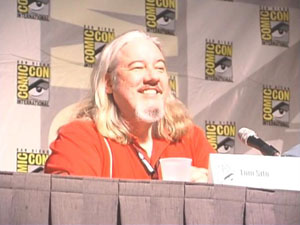 both versions at the same time. In addition, fun facts are spread throughout the episodes, mainly covering the differences from script to screen, and there are profiles of 50 characters, creatures, and artifacts in case you ever become embroiled in a heated debate about just what a "Creeping Horak" is.
both versions at the same time. In addition, fun facts are spread throughout the episodes, mainly covering the differences from script to screen, and there are profiles of 50 characters, creatures, and artifacts in case you ever become embroiled in a heated debate about just what a "Creeping Horak" is.
As before, two postcard-sized art cards are part of the set. The first is by Earl Norem, who painted the designs for the toy box art and also the covers of the books and magazines. Here he does a transformation scene. The second card is by Gilbert Hernandez ("Love and Rockets") and is probably my favorite so far, depicting a cartoonish scene of Mer-Man, Trap Jaw, and Fang Man sneaking up on an unsuspecting Orko and Dree Elle.
The DVD-ROM also contains five scripts in PDF format: "The Dragon's Gift," "The Search," "Temple of the Sun," "Game Plan," and "Pawns of the Game Master." Finally, five DVD spots for the previous and current "He-Man" releases are included, as well.
Conclusion:
BCI continues to impress me with these releases, and this is no different. Volume Two is better than Volume One, so it should be no surprise that I liked it a lot. Recommended.
 BCI's catalogue was composed entirely of public-domain material, microbudget movies, and pornography with titles like "Awesome Strippers"—not exactly a company you trust to do justice to a nostalgic childhood favorite.
BCI's catalogue was composed entirely of public-domain material, microbudget movies, and pornography with titles like "Awesome Strippers"—not exactly a company you trust to do justice to a nostalgic childhood favorite.But then something interesting happened: they released a surprisingly great DVD that set a new bar for video, packaging, and extras for classic animation. Season One, Volume One confirmed it, and suddenly people knew who BCI was. Animation fans started saying things like, "I hope BCI gets the license," or, "I wish Warner Bros. would have given it the 'He-Man' treatment." And last fall's Gone in 60 Seconds: Collector's Edition proved that they could do a loaded live-action special edition just as well as the big guys.
So if this is a new direction that BCI is headed, I would say: keep it up! It seems like fans can expect big things for future releases like "Blackstar" and "The New Adventures of Zorro." Now if they would only announce Flash Gordon: The Greatest Adventure of All, I would be one happy reviewer.
Anyway, He-Man. Season One, Volume Two wraps up the first season of "He-Man and the Masters of the Universe," and by this point, you can tell the writers were a little tired of the standard "Skeletor gains a new power and He-Man must stop him" hijinks of the previous 33 episodes. In fact, it's pretty surprising just how little Skeletor shows up in this set. Even in those cases where he factors into the story, he's not lording some ancient artifact over everyone. He's moved on. He's over that. That's not how he rolls anymore.
Swooping in to fill the bad guy vacuum is an array of inventive one-shot villains from all over Eternia, including Shokoti (a gothic, vampire-like sorceress), Lord Masque (living
 smoke bound to a magical mask), and Darkdream (an evil, robed shadow whose arrival is heralded by nightmares). Not coincidentally, most of the memorable villains have memorable episodes as a result. Skeletor's henchmen get fleshed out, too, with episodes surrounding Evil-Lyn, Mer-Man, Clawful, and especially Trap Jaw operating entirely independently of Skeletor and either working on their own or partnering with someone.
smoke bound to a magical mask), and Darkdream (an evil, robed shadow whose arrival is heralded by nightmares). Not coincidentally, most of the memorable villains have memorable episodes as a result. Skeletor's henchmen get fleshed out, too, with episodes surrounding Evil-Lyn, Mer-Man, Clawful, and especially Trap Jaw operating entirely independently of Skeletor and either working on their own or partnering with someone.In some cases, the bad guys aren't even really bad. Granamyr, the title dragon in "The Dragon's Gift," is basically good, but he's also arrogant, greedy, and completely uncooperative. He also knows (and knows He-Man knows) that he could squish He-Man like a bug, or teleport him to a demon dimension with the slightest provocation.
Even if they are evilish, most of them have no interest in taking over Eternia. Queen Sumana, from "Trouble in Arcadia," runs a sexist Amazonian society that has enslaved all of its men and forces them to work underground in unsafe mines. Lord Tyrin and Lady Valtira were once evil but eventually decide that their love for each other is more important in "The Sleepers Awaken." And Aremesh, a robot made from pure energy in "Return of Evil," is just a mercenary hired to do a job.
You might think that the inconsistant dynamic of the Parade of Villainy means that there would be more mediocre episodes on this set than the first one, but that's really not the case. Of course, there are some genuinely bad episodes. Some of the worst offenders include "It's Not My Fault," a preachy episode about learning to take responsibility; "Valley of Power," about some magic water and a man with an egg; "Return of the Gryphon," about an annoying kid who's more interested in his own popularity than stopping a ridiculous-looking monster from killing people and destroying their homes; and "Quest for the Sword," about a simple-minded rock creature that thinks having a sword makes him a leader.
 Easily the worst of the set, though, is "The Huntsman," an inappropriately political episode that flatly states that hunting should be illegal. Baron Grod, the title character, wants to bag the last unicorn on Eternia, and Adam and Teela are intent on talking him out of it. After greeting them warmly, Grod is given a lecture by the pair on how hunting is evil. When he refuses to back down, they storm out and threaten to have it outlawed. Grod calls up the leader of a tribe of ogres and tells him to kidnap the two until the hunt is complete.
Easily the worst of the set, though, is "The Huntsman," an inappropriately political episode that flatly states that hunting should be illegal. Baron Grod, the title character, wants to bag the last unicorn on Eternia, and Adam and Teela are intent on talking him out of it. After greeting them warmly, Grod is given a lecture by the pair on how hunting is evil. When he refuses to back down, they storm out and threaten to have it outlawed. Grod calls up the leader of a tribe of ogres and tells him to kidnap the two until the hunt is complete.The baron succeeds in his mission—he only places the animals in suspended animation, by the way—and as if there were any doubt as to his character, he flies back in the same model of ship that Skeletor uses. A timely He-Man shows up to free Teela, and together they break down the door to Grod's castle and create havoc by unsuspending various dangerous animals to teach the baron "how it feels to be hunted." He learns his lesson, of course ("I never knew!"), and promises to free the rest of the animals. Back at the palace, King Randor is only too happy to outlaw all hunting, as Teela says, to force "these hunters" not to harm the unicorn, and, I assume, bunny rabbits, pandas, and kittens, too. At the end I thought that maybe Teela would make a statement that not all hunters are like Baron Grod (and will call out a hit on you if you cross them), but the moral was about not losing your cool when you get in an argument.
I don't hunt—hell, I buy free-range eggs and meat, given the choice—but even I was offended by this propagandistic drivel.
In any event, there are more than enough good episodes to balance out the bad ones. In "The Dragon's Gift," the dragon Granamyr demands that He-Man take a life to save a life. "The Search" asks if He-Man can resist the temptation of ultimate power, even if he could use it to wipe out all evil from the universe. Lord Masque, a neat villain in his own right, attempts to resurrect an even greater evil in "House of Shokoti, Part 1," and "House of Shokoti, Part 2" features the wicked sorceress raised by Masque preparing to unleash her evil across Eternia. Darkdream plunges Eternia into permanent midnight in "Eternal Darkness," while Teela and Evil-Lyn have to team up in "The Witch and the Warrior." And, in a turn of events, the ancient dragon must seek He-Man's help in "The Return of Granamyr."
My favorite episode on the set is "Golden Disks
 of Knowledge," however. The episode begins with disconcerting but harmless illusions in Grayskull annoying the Sorceress sufficiently to ask He-Man to help her figure out their cause. Orko discovers that, much to their surprise, Zanthor, a prisoner in the Phantom Zone, is trying to contact them. He says that he seeks to redeem himself, but the Sorceress and Zodac aren't interested. They reveal that Zanthor was once a member of the Council of the Wise, but in a moment of weakness sided with Skeletor by stealing for him the Golden Disks of Knowledge, representing the combined wisdom of the council. This allowed the villain to become the powerful sorcerer he is. Despite this, He-Man convinces them to give Zanthor a chance to atone for his crime, and together the pair infiltrate Snake Mountain in an attempt to recover the disks.
of Knowledge," however. The episode begins with disconcerting but harmless illusions in Grayskull annoying the Sorceress sufficiently to ask He-Man to help her figure out their cause. Orko discovers that, much to their surprise, Zanthor, a prisoner in the Phantom Zone, is trying to contact them. He says that he seeks to redeem himself, but the Sorceress and Zodac aren't interested. They reveal that Zanthor was once a member of the Council of the Wise, but in a moment of weakness sided with Skeletor by stealing for him the Golden Disks of Knowledge, representing the combined wisdom of the council. This allowed the villain to become the powerful sorcerer he is. Despite this, He-Man convinces them to give Zanthor a chance to atone for his crime, and together the pair infiltrate Snake Mountain in an attempt to recover the disks.So these episodes, like the last set, represent a mixed bag, but the selection is better overall. Unlike ThunderCats, the writers for "He-Man and the Masters of the Universe" recognized the rut they were digging in the first 33 episodes and decided to use the back half to expand the world of Eternia, adding to its backstory and introducing lots of interesting new characters. Skeletor is one of the most fun characters on the show; who would have thought it would get better with less of him around?
Video:
As with all of the "He-Man" DVD releases, the show is adapted from a cleaned-up PAL transfer, and it looks sharp (certainly better than it ever looked during the original broadcasts). The main problem is present in every set: anytime there's a lot of movement on screen (for example, during a fast pan, or when Cringer is transformed into Battle Cat), there is an obscene amount of pixelation. Besides the transformation scene, the other cases happen only a few times on the set. But it's an encoding issue that still needs to be corrected, and I continue to hope that it will be fixed for Season Two, Volume One.
Audio:
The language tracks consist of English and Spanish Dolby 2.0 stereo. As a result of the PAL transfer, everything is sped up by four percent, meaning voices are slightly more high-pitched than you may remember them. I didn't notice any difference, though.
Additionally, the "He-Man Invades the San Diego Comic-Con" extra is in Dolby 5.1. The rear channels are
 mainly reserved for crowd noise.
mainly reserved for crowd noise.Packaging and Menus:
The set looks better than most big studio releases, with nice, large character designs on the discs and glossy scenes in the folds of the digipak. The spine features part of an image of Castle Grayskull; if you collect all four boxes it will form the complete image. As before, the opposite side is neon-colored; this time it's a disturbing shade of hot pink.
The menus are stylish but slow, especially in the episode navigation; on a slower player you might wonder if the thing has locked up. Also, when you load a disc, you are irritatingly forced to wait through all the company logos, since all buttons are disabled until you get to the main menu. Still no chapter skip; at this point I'm guessing there's not going to be one.
Extras:
Two more documentaries are on the set. "The Stories of He-Man and the Masters of the Universe" (0:30) picks up where the last one left off, and the writers, artists, directors, and producers weigh in on various episodes. Robby London explains of "Double Edged Sword" that he was concerned that action-adventure shows always showed people fighting, but no one really getting hurt. Children, especially small children, have a tough time making the distinction between fiction and reality, and so he used the episode to show that in real life people can get hurt—even the good guys. Tom Sito usually has at least one hilarious story per doc, and Paul Dini, always interesting to listen to, manages to get a jab in at Orko.
"He-Man Invades the San Diego Comic-Con" (0:37) is exactly what it sounds like. The first half, which features some of the more hardcore fans, serves as a good reminder why I avoid comic conventions. (Just kidding, He-Man fans! Don't hurt me!) The second half (starting at 0:18) is a roundtable with Erika Scheimer, Lou Scheimer, Tom Sito, Tom Tataranowicz, and Jeff Hayne, and is a lot of fun.
A storyboard version of "House of Shokoti, Part 1" is also on the disc, and allows you to view
 both versions at the same time. In addition, fun facts are spread throughout the episodes, mainly covering the differences from script to screen, and there are profiles of 50 characters, creatures, and artifacts in case you ever become embroiled in a heated debate about just what a "Creeping Horak" is.
both versions at the same time. In addition, fun facts are spread throughout the episodes, mainly covering the differences from script to screen, and there are profiles of 50 characters, creatures, and artifacts in case you ever become embroiled in a heated debate about just what a "Creeping Horak" is.As before, two postcard-sized art cards are part of the set. The first is by Earl Norem, who painted the designs for the toy box art and also the covers of the books and magazines. Here he does a transformation scene. The second card is by Gilbert Hernandez ("Love and Rockets") and is probably my favorite so far, depicting a cartoonish scene of Mer-Man, Trap Jaw, and Fang Man sneaking up on an unsuspecting Orko and Dree Elle.
The DVD-ROM also contains five scripts in PDF format: "The Dragon's Gift," "The Search," "Temple of the Sun," "Game Plan," and "Pawns of the Game Master." Finally, five DVD spots for the previous and current "He-Man" releases are included, as well.
Conclusion:
BCI continues to impress me with these releases, and this is no different. Volume Two is better than Volume One, so it should be no surprise that I liked it a lot. Recommended.
|
| Popular Reviews |
| Sponsored Links |
|
|
| Sponsored Links |
|
|
| Release List | Reviews | Shop | Newsletter | Forum | DVD Giveaways | Blu-Ray | Advertise |
|
Copyright 2024 DVDTalk.com All Rights Reserved. Legal Info, Privacy Policy, Terms of Use,
Manage Preferences,
Your Privacy Choices | |||||||









